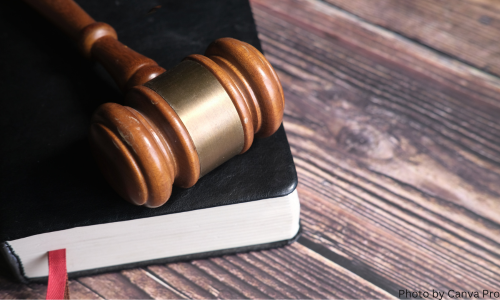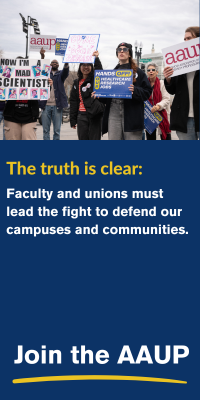- About
- Programs
- Issues
- Academic Freedom
- Political Attacks on Higher Education
- Resources on Collective Bargaining
- Shared Governance
- Campus Protests
- Faculty Compensation
- Racial Justice
- Diversity in Higher Ed
- Financial Crisis
- Privatization and OPMs
- Contingent Faculty Positions
- Tenure
- Workplace Issues
- Gender and Sexuality in Higher Ed
- Targeted Harassment
- Intellectual Property & Copyright
- Civility
- The Family and Medical Leave Act
- Pregnancy in the Academy
- Publications
- Data
- News
- Membership
- Chapters
Robert Really Does Rule!
Why Robert's Rules are the BEST for faculty meetings.

I recently heard some faculty members complain that employing Robert’s Rules at faculty senate meetings was “exclusionary” and a “waste of time.” Nothing could be further from the truth! I have participated in faculty meetings and find the precise rules for speech, and the requirement to phrase things just so, to be an incomparable asset to democratic decision-making. After all, the author, Henry Martyn Robert, was a US Army officer, and who knows better, when it comes to spreading democracy, than the US Army?
I am a zealot, a fan, a fanatic, a follower when it comes to Robert’s Rules! If we don’t have rules, what do we have? Chaos! Take, for instance, the following transcript of a recent faculty senate meeting where we discussed a pressing issue. I shudder to think how such a conversation would have unfolded without Robert’s Rules.
PRESIDER. I want to remind everyone that this meeting is set to adjourn at 7:24 p.m., and not a minute later. We have a lot of pressing business, which is why we scheduled this meeting on a Friday night.
FACULTY MEMBER WISHING TO SPEAK (FMWS) raises hand.
PRESIDER. Faculty Member Wishing to Speak, there is no motion on the table and people may speak only when a motion has been moved. That is in footnote 313 in Robert’s Rules of Order (p. 807, 29th edition). Please familiarize yourself with it.
FMWS. There is some important news—
PRESIDER. Please! You do not have the floor! It is highly out of order to speak without being called upon. This is not the time to share news.
You see here the genius of General Robert? Robert anticipated derailed agendas and random expressions of thought or feeling, and that’s why we need these simple rules. We must control the conditions under which people are allowed to communicate with each other and what they are allowed to communicate about!
PRESIDER. I call on the chair of the Special Presidential Task Force for Strategic Planning with Limited Funds (SPTFSPLF) to present the joint motion with the Curriculum Committee.
CHAIR OF SPTFSPLF. We have a unanimous motion from the two committees in front of us today. I wager these are the most sharedly governed committees on our campus, with equal representation of students, faculty, staff, and administrators. We are working on adding an equal number of alums, and also an equal number of college lawyers to these committees—frankly, leaving them off was a huge oversight on our part, and so reflective of the silos that academia encourages us to maintain.
But, moving on: The student members of these two committees report long-standing suffering of their classmates. Suffering that we have turned a blind eye to. Due to the unanticipated large cohorts seeking admission at the college for the last several years, we have a severe housing shortage. The result of this shortage has been to turn singles into triples, doubles into “quints,” and quads into “the baker’s dozen.” Basement storage rooms and broom closets have been turned into doubles and singles, respectively. Our crumbling infrastructure has also meant that many of these rooms lack proper ventilation and heating. The distress of their living conditions has increased student stress, which in turn has caused them to be cranky and lethargic, which in turn has led to lower performance in curricular matters and increased student complaints. And we can all do with fewer of those, am I right? Ha ha. This joke is met with silence except for one person who appears to be on the phone. Ahem . . . yes, so after doing an environmental scan of our peer schools, arranging several urgent meetings on weekends, consulting with the Student Government Association (which has given its unanimous support), and reading through several blogs, and watching even more TikTok videos at all hours of the night, we propose the following motion:
Be it RESOLVED that all dorms and classrooms be painted yellow—a color described in some nonscientific research as improving mood and lowering stress.
PRESIDER. The motion in front of us is to paint all dorms and classrooms yellow. Many hands go up. I will remind people that only those speaking to this motion may speak now. FMWS lowers hand.
FIRST MEMBER. I think this is a great motion, and frankly, long overdue. I am in full support of this and thank the committees for working so hard on this motion, that is, frankly, to the benefit of all of us. This is a very creative solution indeed.
SECOND MEMBER. I have a point of clarification: Will we be using lead-free paint?
CHAIR OF SPTFSPLF. We looked into that, but it turns out that we can’t afford some of these newfangled paints with “no lead” and “zero fumes.” Our budget allows us to buy paint only from the basement of some dude who’s been hanging on to these cans for sixty years. But in the spirit of shared governance, and keeping in mind that we do have a very limited budget, we felt it was necessary to bring this forward for collective deliberation, regardless of the concerns about lead paint. We do believe that the lead paint will be an improvement over the current living conditions of our students.
THIRD MEMBER. I guess my question is about the color “yellow.” What kind of “yellow” are we using? Because I can get behind “lemon, gumdrop, creamsicle, macaroon”; I am less sure about “daffodil”; and I am absolutely opposed to “canary, butter, corn, dandelion, or bumblebee.” I would like to propose an amendment that adds the words “lemon, gumdrop, creamsicle, and macaroon” before the word “yellow” in the motion.
Thank you. Again, very important work.
My dear readers, do you not see how proper all of this is? Can you honestly tell me that another system could be better? Here, General Robert anticipated that the “brains behind the motion” may not have the wisdom of the deliberative body. The deliberative body was empowered here to add a crucial clarification via an amendment.
PRESIDER. We have a motion to amend. Do I have a second? Seconded. We are now debating the amendment to add the following words to the motion: “lemon, gumdrop, creamsicle, and macaroon.”
FOURTH MEMBER. I am in favor of this amendment. It adds a level of clarity that was lacking before. But I’m not sure “creamsicle” qualifies as “yellow.” I mean, it seems like we get more bang for our buck if we go for an obvious yellow. I move to strike out “creamsicle” from this list and add “daffodil.”
FMWS. Please! None of this is important! There is important news—
PRESIDER. Faculty Member Wishing to Speak! Please behave appropriately or this assembly will be forced to censure such uncouth behavior! You do not speak unless you are called upon. And I have not called on you. We have important work to do! We now have a secondary amendment to strike out “creamsicle” and add “daffodil.” Seconded. We will now debate the amendment to the amendment which is to strike out “creamsicle” but leave “lemon, gumdrop, and macaroon” in place and add “daffodil.”
THIRD MEMBER. Can I make a case for reinserting “creamsicle”? Surely that is yellow! I would like to amend to add “creamsicle” back.
PRESIDER. We now have an amendment to the amendment to the amendment . . . Umm, wait, no? Stand at ease, please, while I consult with our parliamentarian. Intense whispering between parliamentarian and presider.
PRESIDER. Our esteemed Parliamentarian informs me that an amendment to the amendment to the amendment is not allowed. So, we will discuss only the amendment to the amendment. We will not reinsert “creamsicle.”
Now here it might seem that Robert’s Rules have become restrictive, but, in fact, had the presider allowed the addition of “creamsicle,” it would have been a short and slippery slope to this meeting’s turning into a shouting match where various hues otherwise known as yellow were lobbed across the assembly hall.
FIFTH MEMBER. Point of clarification: Do we debate the first amendment first and the second amendment second or do we debate the second amendment first and the first one second?
PRESIDER. Yes . . . that is correct . . . the second one is, I mean the second first and then the first second.
FMWS. Please! I have some important news to share. We all received emails at the beginning of this meeting. The college president announced that the college is closing and we no longer have jobs! The board of trustees has decided to turn our campus into a seaside resort. We are asked not to report to work tomorrow, unless we have cocktail-mixing skills that match Tom Cruise’s!
PRESIDER, banging on the gavel. That’s enough! Faculty Member Wishing to Speak, you are out of order. This clearly does not pertain to the business at hand! You are wasting this assembly’s time with matters that are not germane to the motion. Oh! Look at that! We are out of time! This meeting is now adjourned.
If that doesn’t convince you of Robert’s usefulness, I don’t know what will. So many disastrous conversations were avoided! All in one meeting!
I miss those days. As I sit here, scrolling through job ads, in between the cocktail-mixing tutorials on YouTube that I am now addicted to, I long for debate under Robert’s Rules. So much work accomplished in so little time! So much meaningful deliberation marked by clarity and inclusiveness. The only place that comes close to such principled and inclusive debate is the US Senate. Sadly, they’re not responding to my application as bartender.
This satire is a companion piece to Afshan Jafar’s fall 2024 Academe article, “Time to Show Robert the Door.”
Afshan Jafar is May Buckley Sadowski ’19 Professor and chair of sociology at Connecticut College. She is the chair of the AAUP’s Committee on College and University Governance. Her email address is [email protected]. Sheetal Chhabria is associate professor of history at Connecticut College and the author of Making the Modern Slum: The Power of Capital in Colonial Bombay, which won the American Historical Association’s 2020 John F. Richards Prize for South Asian History. Her email address is [email protected].



